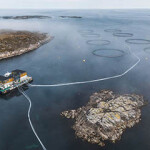Russia mulling ban on exports of salmon, salmon roe

Russia is considering a ban on exports of salmon and salmon roe as a drop in catch compared to 2021 is driving up prices.
In September 2022, wholesale prices for humpback (pink) salmon increased by 28 percent compared to August, reaching RUB 320,000 (USD 5,135, EUR 5,207) per metric ton (MT). Chum salmon prices also increased, rising 22 percent over the previous month to RUB 440,000 (USD 7,060, EUR 7,167) per MT, Kommersant business reported – citing a letter sent from the All-Russian Association of Fishing Industry (VARPE) to Russia's Ministry of Agriculture.
In early September, Russian Federal Agency for Fisheries Head Ilya Shestakov put forth an initiative to temporarily suspend exports of some of the highest-yielding salmon species due to relatively low catches this year. Shestakov said the initiative is an effort to fulfill the domestic market’s demand, a top priority for Russia’s government.
The fishery agency proposed the ban to the Russian Ministry of Agriculture and that the ministry is now conducting consultations with businesses and trade associations.
In May 2022, before Russia's salmon season kicked off on 1 June, Shestakov repeatedly talked about a possible ban due to low catch projections. Thus far, the catch has been in line with scientific predictions, and Shestakov renewed his calls for an export ban beginning in September.
“This year we don’t have a good salmon season,” Shestakov said in an interview aired by NTV. “In 2020, it was not much better, but when compared with 2021, we see a sharp drop. We want to use an export ban to mitigate price growth we’re seeing now and guarantee sufficient supplies to the domestic market. I hope a final decision will soon be accepted.”
Russia also experienced low salmon catches in 2014, 2015, and 2020, but no export ban was ever been put in place previously. This year, the salmon catch is around 2014 and 2020 levels, but the strengthening of the ruble has made exports less profitable than in years past.
Through 3 October, 263,000 MT of salmon had been caught, down 50.1 percent year-on-year. As a result, the production volume of salmon roe has dropped, and retail prices for both roe and salmon have increased.
According to the Federal Agency for Fisheries forecasts, only 8,000 to 9,000 MT of salmon roe will be produced in the country, half of what was produced in 2021. Salmon roe is a popular product Russians eat regularly – a delicacy usually consumed on special occasions like birthdays, weddings, and New Years Eve parties. It’s typically eaten in smaller quantities, and an increase in price is typically not a hot-button topic socially and it doesn’t factor much into nutrition and food security. However, it’s an issue that always gets a lot of attention from the press – often forcing the government to act.
VARPE said that an export ban would likely have a downward impact on prices.
Photo courtesy of Nadya So/Shutterstock






Share